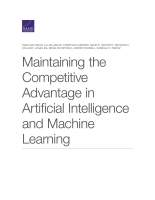by Rand Waltzman
What key differences in cultural and structural factors affect the implementation of U.S. and Chinese AI strategies?
How do these differences affect military capability development relevant to USAF?
How can the USAF establish a competitive advantage in militarily relevant AI capabilities?
Artificial intelligence (AI) technologies hold the potential to become critical force multipliers in future armed conflicts. The People's Republic of China has identified AI as key to its goal of enhancing its national competitiveness and protecting its national security. If its current AI plan is successful, China will achieve a substantial military advantage over the United States and its allies. That has significant negative strategic implications for the United States. How much of a lead does the United States have, and what do the United States and the U.S. Air Force (USAF) need to do to maintain that lead? To address this question, the authors conducted a comparative analysis of U.S. and Chinese AI strategies, cultural and structural factors, and military capability development, examining the relevant literature in both English and Chinese. They looked at literature on trends and breakthroughs, business concerns, comparative cultural analysis, and military science and operational concepts. The authors found that the critical dimensions for the U.S. Department of Defense (DoD) involve development and engineering for transitioning AI to the military; advances in validation, verification, testing, and evaluation; and operational concepts for AI. Significantly, each of these dimensions is under direct DoD control.
Key Findings
It is difficult, perhaps impossible, to arrive at a definitive statement about which country has the lead in AI. It is more useful to talk about various parts of the AI ecosystem. It appears possible that the United States has a narrow lead in several key areas of AI, although China has several advantages and a high degree of leadership focus on this issue.
As of early 2020, the United States has a modest lead in AI technology development because of its substantial advantage in the advanced semiconductor sector. China is attempting to erode this edge through massive government investment. The lack of a substantial U.S. industrial policy also works to Chinese advantage.
China has an advantage over the United States in the area of big data sets that are essential to the development of AI applications. This is partly because data collection by the Chinese government and large Chinese tech companies is not constrained by privacy laws and protections. However, the Chinese advantage in data volume is probably insufficient to overcome the U.S. edge in semiconductors.
Breakthrough fundamental research is not a critical dimension for comparing U.S.-China relative competitive standing from a DoD perspective. Fundamental research, regardless of whether it is U.S., Chinese, or a U.S.-Chinese collaboration, is available to all.
Commercial industry is also not a critical dimension for competitive comparison. Industries with corporate headquarters in the United States and in China seek to provide products and services wherever the market is.
Recommendations
Manage expectations by developing and maintaining a forward-looking AI roadmap, highlighting realistic goals for DoD AI employment for near (one to two years), middle (three to five years) and far (six to ten years) terms.
Create an engineering pipeline under DoD control.
Create and tailor verification, validation, and evaluation techniques for AI technologies.
Create development, test, and evaluation processes for new operational concepts that employ AI.

No comments:
Post a Comment